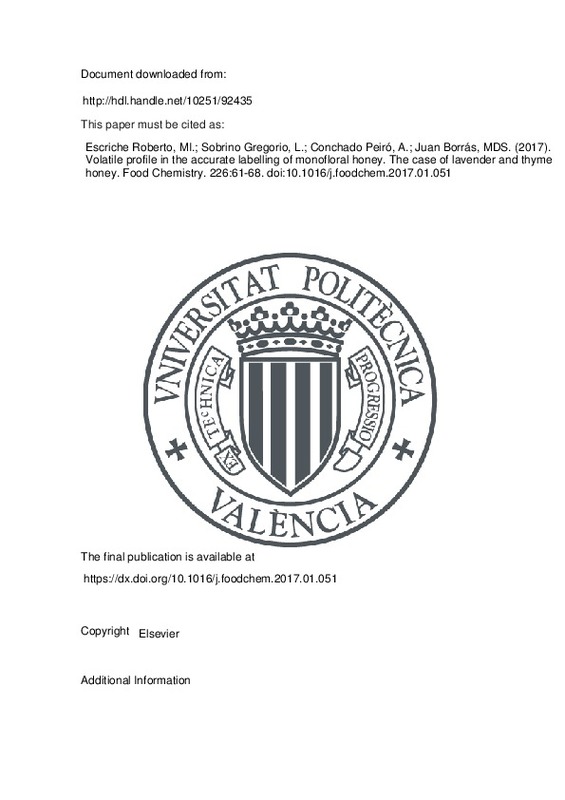JavaScript is disabled for your browser. Some features of this site may not work without it.
Buscar en RiuNet
Listar
Mi cuenta
Estadísticas
Ayuda RiuNet
Admin. UPV
Volatile profile in the accurate labelling of monofloral honey. The case of lavender and thyme honey
Mostrar el registro sencillo del ítem
Ficheros en el ítem
| dc.contributor.author | Escriche Roberto, Mª Isabel
|
es_ES |
| dc.contributor.author | Sobrino Gregorio, Lara
|
es_ES |
| dc.contributor.author | Conchado Peiró, Andrea
|
es_ES |
| dc.contributor.author | Juan Borrás, María del Sol
|
es_ES |
| dc.date.accessioned | 2017-12-11T12:30:28Z | |
| dc.date.available | 2017-12-11T12:30:28Z | |
| dc.date.issued | 2017 | es_ES |
| dc.identifier.issn | 0308-8146 | es_ES |
| dc.identifier.uri | http://hdl.handle.net/10251/92435 | |
| dc.description.abstract | [EN] The proliferation of hybrid plant varieties without pollen, such as lavender, has complicated the classification of specific types of honey. This study evaluated the correlation between the proclaimed type of monofloral honey (lavender or thyme) as appears on the label with the actual percentage of pollen. In addition, physicochemical parameters, colour, olfacto-gustatory profile, and volatile compounds were tested. All of the samples labelled as lavender were wrongly classified according to the usual commercial criteria (minimum 10% of pollen Lavandula spp.). In the case of lavender honey, there was significant agreement between commercial labelling and classification through organoleptic perception (81.8%), and above all between the commercial labelling and the volatile compounds (90.9%). For thyme honey, agreement for both parameters was 90.0%. These results offer compelling evidence that the volatile compounds are useful for the classification of lavender honey with low levels of pollen since this technique agrees well with the organoleptic analysis. | es_ES |
| dc.description.sponsorship | The authors thank the Generalitat Valenciana (Spain) for funding the project AICO/2015/104. | en_EN |
| dc.language | Inglés | es_ES |
| dc.publisher | Elsevier | es_ES |
| dc.relation.ispartof | Food Chemistry | es_ES |
| dc.rights | Reserva de todos los derechos | es_ES |
| dc.subject | Accurate labelling | es_ES |
| dc.subject | Lavender honey classification | es_ES |
| dc.subject | Thyme honey | es_ES |
| dc.subject | Volatile compounds | es_ES |
| dc.subject | GC MS | es_ES |
| dc.subject.classification | ESTADISTICA E INVESTIGACION OPERATIVA | es_ES |
| dc.subject.classification | TECNOLOGIA DE ALIMENTOS | es_ES |
| dc.title | Volatile profile in the accurate labelling of monofloral honey. The case of lavender and thyme honey | es_ES |
| dc.type | Artículo | es_ES |
| dc.identifier.doi | 10.1016/j.foodchem.2017.01.051 | es_ES |
| dc.relation.projectID | info:eu-repo/grantAgreement/GVA//AICO%2F2015%2F104/ | |
| dc.rights.accessRights | Abierto | es_ES |
| dc.date.embargoEndDate | 2018-07-02 | es_ES |
| dc.contributor.affiliation | Universitat Politècnica de València. Departamento de Tecnología de Alimentos - Departament de Tecnologia d'Aliments | es_ES |
| dc.contributor.affiliation | Universitat Politècnica de València. Departamento de Estadística e Investigación Operativa Aplicadas y Calidad - Departament d'Estadística i Investigació Operativa Aplicades i Qualitat | es_ES |
| dc.contributor.affiliation | Universitat Politècnica de València. Instituto Universitario de Ingeniería de Alimentos para el Desarrollo - Institut Universitari d'Enginyeria d'Aliments per al Desenvolupament | es_ES |
| dc.description.bibliographicCitation | Escriche Roberto, MI.; Sobrino Gregorio, L.; Conchado Peiró, A.; Juan Borrás, MDS. (2017). Volatile profile in the accurate labelling of monofloral honey. The case of lavender and thyme honey. Food Chemistry. 226:61-68. https://doi.org/10.1016/j.foodchem.2017.01.051 | es_ES |
| dc.description.accrualMethod | S | es_ES |
| dc.relation.publisherversion | https://dx.doi.org/10.1016/j.foodchem.2017.01.051 | es_ES |
| dc.description.upvformatpinicio | 61 | es_ES |
| dc.description.upvformatpfin | 68 | es_ES |
| dc.type.version | info:eu-repo/semantics/publishedVersion | es_ES |
| dc.description.volume | 226 | es_ES |
| dc.relation.pasarela | S\324981 | es_ES |
| dc.contributor.funder | Generalitat Valenciana | es_ES |







![[Cerrado]](/themes/UPV/images/candado.png)

